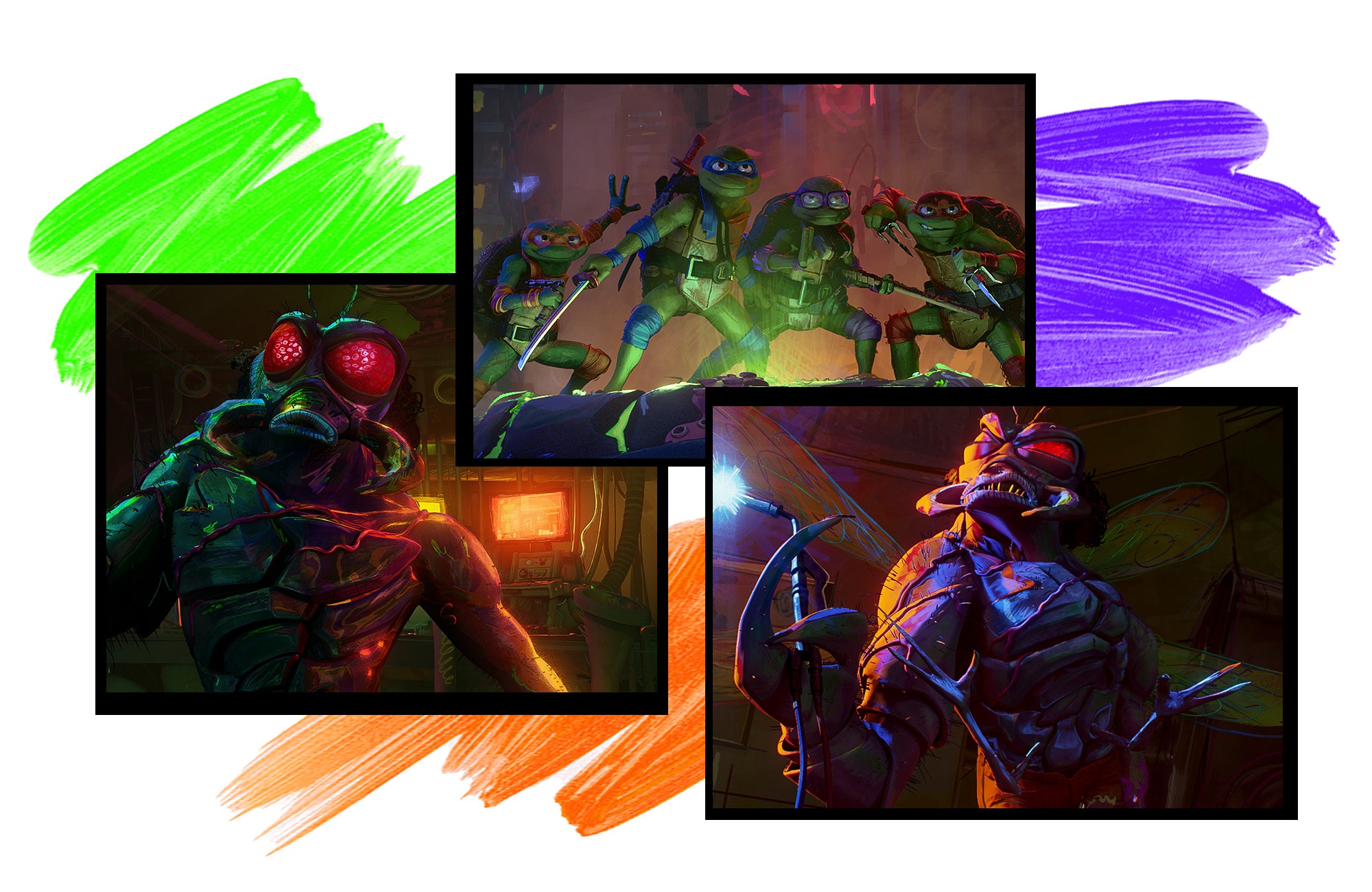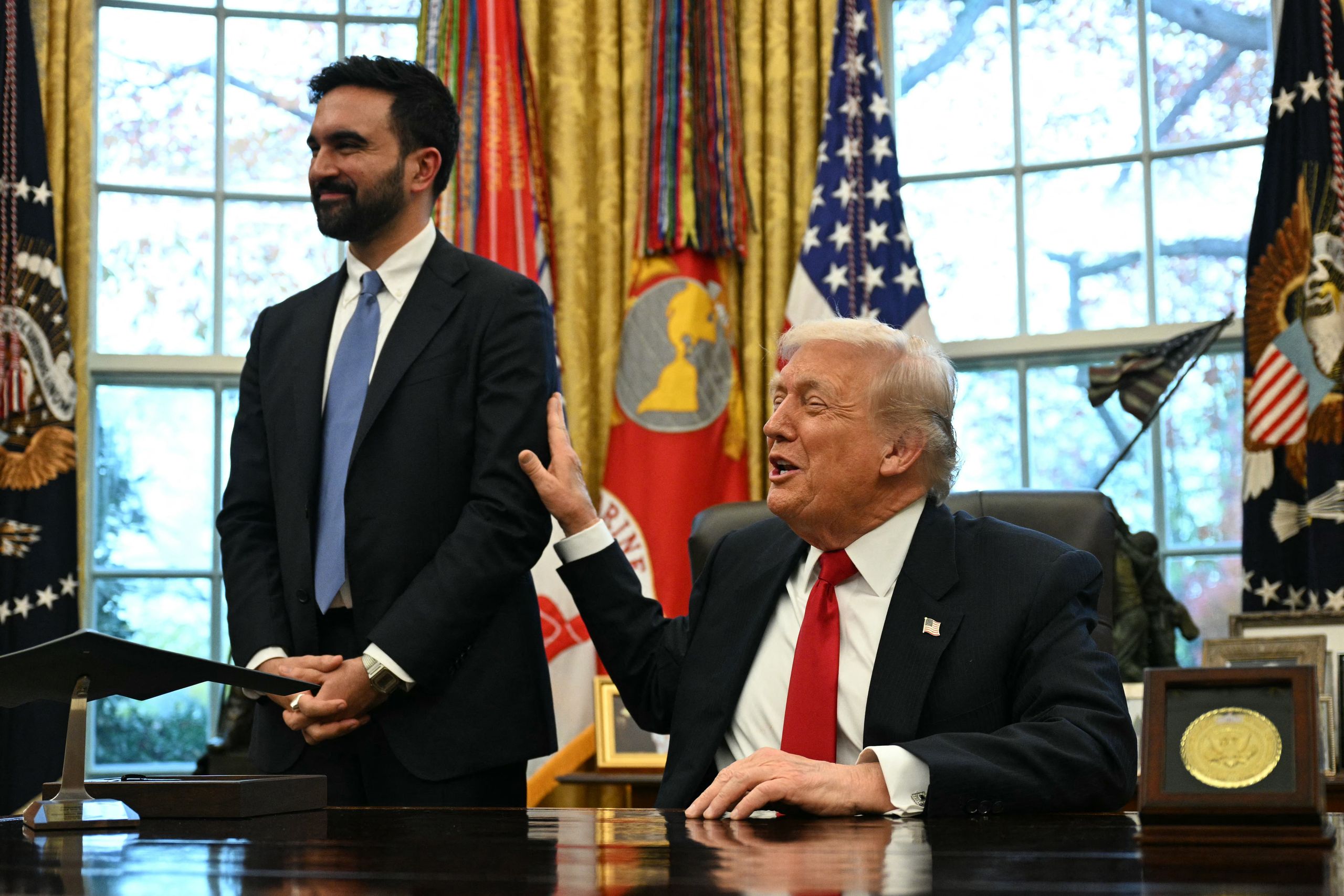"Mejor que Mark Ruffalo": Dentro del final salvaje y alegre de Teenage Mutant Ninja Turtles: Mutant Mayhem | Vanity Fair.

Por Katey Rich
"¿Un pequeño caballo? No necesito ese caballo."
Según Seth Rogen, el remate que desinfla una escena climática hacia el final de TMNT: Mutant Mayhem fue improvisado en una cabina de grabación por Ice Cube, a quien se le dijo que imaginara lo que diría un gigante mutante hecho de animales mientras pisotea Manhattan. No es el tipo de cosa que cualquier actor pueda conjurar fácilmente por sí solo, y durante mucho tiempo en el desarrollo de la película, se suponía que el mutante solo rugía, no hablaba. Pero en algún momento, dice Rogen, "pensamos: '¿Qué tal si es este monstruo gigante, pero sigue sonando como Ice Cube?'".
Ese tipo de desarrollo de la historia, lo que sucedería si ocurriera algo loco, se convierte en una parte importante del folclore de Mutant Mayhem cuando hablas con Rogen y Jeff Rowe, el director de la película, quienes guiaron a la película a través de una revisión de la historia tras otra en su camino para convertirse en una de las sorpresas más agradables de 2023. Un proyecto de las Tortugas Ninja con un gran énfasis en la parte "adolescente", tiene la dulce torpeza de Superbad de Rogen y Evan Goldberg, a la que se refieren a menudo al hablar de Mutant Mayhem. Pero también es una película de acción inventiva e infinitamente divertida, que culmina en una batalla de kaijus en las calles de Nueva York que dedica tiempo al desarrollo de los personajes de las cuatro tortugas; una transmisión de noticias heroica para su amiga April O'Neill; y un grupo de neoyorquinos unidos en lo que Rogen llama libremente su "momento Spider-Man 2". Así es como lo lograron.
A lo largo de Mutant Mayhem, nuestros héroes adolescentes Leo, Donnie, Raph y Mikey solo han querido ser aceptados por la sociedad humana. Han determinado que derrotar al villano Superfly (Ice Cube) y a su propia familia de mutantes es la forma de lograrlo. Pero sus esfuerzos solo crean una versión más grande y aterradora de Superfly, que luego provoca estragos en la ciudad de Nueva York. A medida que comienza el clímax de acción de la película, las tortugas marchan hacia Manhattan con un arma que creen que puede resolver todo el problema y hacer que los humanos finalmente los acepten. Al mismo tiempo, su padre adoptivo Splinter (Jackie Chan) se ha dado cuenta de que tiene que dejar que sus hijos marchen hacia el peligro, pero aún no ha dejado de temer a los humanos. Todos, resulta, aún tienen algo que aprender.
"Es algo a lo que siempre aspiro, y en realidad creo que lo hicimos bien en ese momento, el público siente que les estás dando la respuesta, pero en realidad es una respuesta incompleta", dice Rogen. Cuando este enfoque funciona bien, dice, el público obtiene la emoción de ver revelada una solución aún mejor junto con los personajes. "Hoy en día hay altos estándares para las películas animadas", dice Rogen. "Había un esfuerzo muy consciente de que el tercer acto continuara brindando este tipo de catarsis emocional. Es agradable, creo, que el público también se embarque en ese viaje".
Al igual que muchas películas animadas, la historia de Mutant Mayhem cambió drásticamente durante su producción. Llegaron muy lejos en el proceso con un monstruo del tercer acto que no era Superfly en absoluto: en un momento dado, el enemigo fue creado por Shredder, el icónico villano de las Tortugas Ninja que ahora solo aparece brevemente al final de la película. Aunque la parte de la historia no estaba funcionando, la animación ya había comenzado. Como dice Rowe, "ya habíamos empezado a construirlo, y era un recurso grande, caro y complicado... Y luego, en algún momento, Seth dijo: '¿No tendría más sentido en lugar de que Superfly cree un monstruo, si él simplemente se convirtiera en el monstruo?'"
El resultado, según Rowe, fue una carrera contrarreloj de 48 horas para convertir al monstruo preexistente, un conjunto de animales que formaban una forma vagamente similar a Godzilla, en algo que concebiblemente podría haber sido una vez el mutante insecto Superfly. "Fue como: '¿Podemos poner alas de mosca y ojos de mosca en este gigantesco monstruo ballena?'" recuerda Rowe. "Cuando lo hicimos, la historia encajó en su lugar. Pero si no hubiéramos invertido tanto tiempo y energía en ese recurso, podríamos haber tenido un final diferente para la película".
Hay cinco escritores acreditados en la película, con Dan Hernandez y Benji Samit recibiendo crédito por el producto final junto con Rogen, Goldberg y Rowe. Para Rogen, quien comenzó a escribir guiones con Goldberg cuando tenía 13 años y ha pasado los últimos años supervisando series de televisión como The Boys y Preacher, un equipo tan grande solo es una ventaja. "Realmente pusimos a prueba y exploramos", dice sobre el proceso de escritura de los cinco hombres, "y eso es lo bueno de la animación, lo pones en movimiento y lo ves para ver si funciona".
After the turtles have tried and failed once to take down Superfly, they regroup and give each other a pep talk, with each turtle reminded of his unique strengths. The distinction among the turtles was essential for the toy-buying fans of the early ’90s—Leonard is the leader, Michelangelo’s a party dude—but for Rogen and Rowe, the team dynamic was much more important to the story they wanted to tell. That was one thing, actually, they didn’t want to steal from Superbad. “We very much didn’t want the story to be about the conflict that they had as characters amongst themselves—mostly because that’s just a thing we’ve done a lot,” Rogen says, “They have conflict, but together they’re a unit and they love each other, and they’re all they’ve ever had.”
Rowe contrasts it to his work on 2021’s Mitchells vs. the Machines, which he cowrote with director Michael Rianda; the film centers on a family of four, but the father and daughter carry the key emotional beats. “Any time we tried to do that with this film, it didn’t feel right,” Rowe says. “The other characters felt underserved.” Eventually he learned that the performances from the teenage voice actors (Micah Abbey, Shamon Brown Jr., Nicolas Cantu, and Brady Noon) would allow each character to be distinct even while being united in their goals. “When we started recording them all together and the way they would all riff with each other,” Rowe says, “They just felt equal.”
Which brings us to Mark Ruffalo. When the boys are doubting themselves the most, Leo reminds his brother Mikey of what he does “better than anyone—even Mark Ruffalo.” The answer is “improvise,” a callback to an earlier throwaway joke in the film about a supposedly improvised scene in Avengers: Endgame, and it’s the moment that gives Mikey the boost he needs to move forward. Except, according to Rogen, “I actually have no idea if it was improvised or not.” And they haven’t heard from Ruffalo. “But I hope if he sees it, he’s happy about it.”
After the turtles regroup, they resume their fight against Superfly, but they’re quickly outmatched. As the monster squeezes them in his fist (a giant lobster claw, of course), Splinter is knocked to the ground and cowers as a group of humans approach him—only to offer to help take him to the hospital, or a veterinarian. Thus begins the Spider-Man 2–esque sequence of humans banding together to help save the day, which both non-New Yorkers Rogen and Rowe swear matches their experience in the city. “I was there a few months ago when there was that insane rainstorm and the whole city was flooding, and I just sat in a furniture store with 50 people for an hour,” says Rogen. “And it was lovely. It was a sense of community that New York has.”
Given that the turtles and Splinter had spent the entire movie to this point ostracized by society, Rowe says, “It felt important to give humanity a win if we wanted to end in a place with the turtles being accepted by them.” As the sequence moves forward, it ends with the four turtles tossing the Superfly-destroying weapon back and forth to each other in a fluid bit of action that, Rowe says, wasn’t nearly as good until their director of cinematography Kent Seki stepped in. “He was like, ‘I think this needs to be better. I’m going to try something,’” Rowe remembers, “And everyone was like, ‘Kent, we don’t have time. We cannot try anything…. It’s just not going to work.’ And then when we saw it, we’re like, we can’t unsee this. He was basically going to hold everyone hostage with quality work, which is the best situation.”




